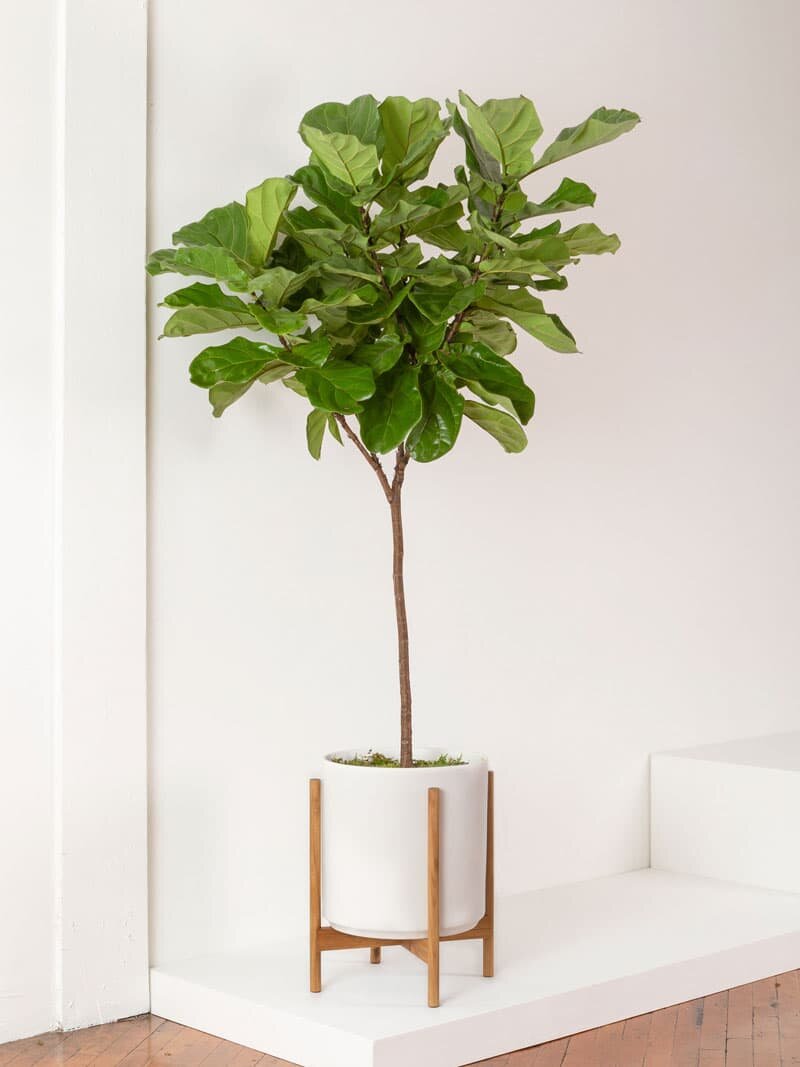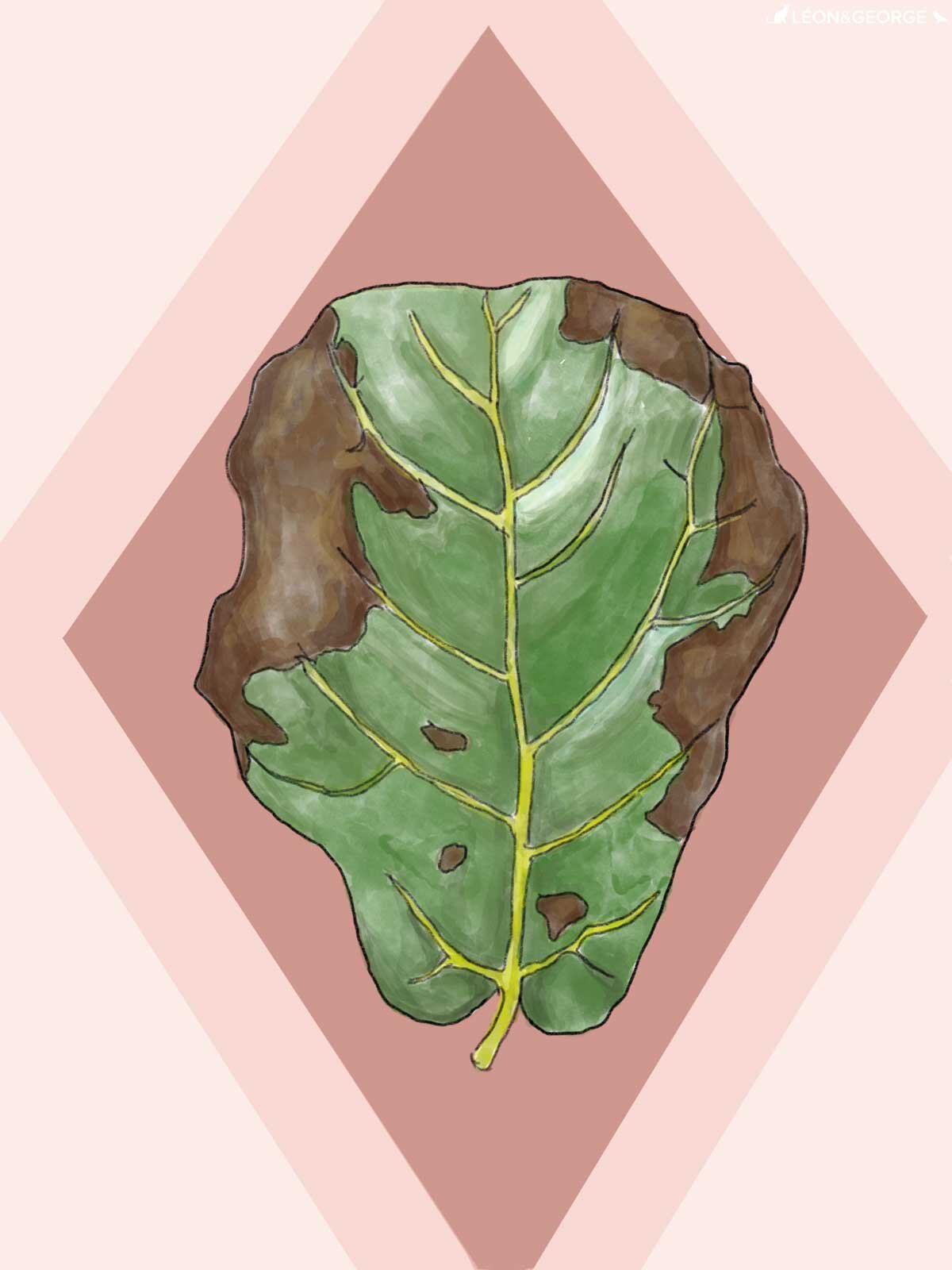How to Care for and Grow Your Fiddle Leaf Fig TREE
The Fiddle Leaf Fig Tree, known for its sculptural shape and stick-thin trunk, is arguably the “it” plant of the moment. If you are not familiar yet, you will be soon: this incredibly gorgeous tree, which also comes in bush or columnar form, appears in magazines, design blogs, and all over Instagram. But despite the popularity, the Fiddle Leaf Fig is not necessarily the easiest of plants to take care of. It is notoriously finicky, and is known to drop leaves with even the most minimal change in its watering schedule, temperature, or environment. Worth it? We think so. Read on for simple tips on how to care for and grow the Fiddle Leaf Fig Tree.
Light Requirements for Fiddle Leaf Fig Trees
The Fiddle prefers bright indirect light — and a lot of it. If you place this plant in an area of medium to low light, it will quickly start to lose leaves. However, leaves may scorch in harsh direct sunlight, so keep it out of strong rays of sun. Read our guide on finding the perfect placement of your Fiddle Leaf Fig.
How to water Fiddle Leaf Fig Trees
Water thoroughly when topsoil is dry, usually once every ten days or so. Avoid overwatering, and keep in mind that watering schedule may be less frequent during winter months. Read our ultimate guide to watering the Fiddle Leaf Fig Tree.
Fiddle Leaf Fig Growth Rate
In prime conditions, the Fiddle Leaf Fig Tree is a fast grower and can grow up to 10 feet tall indoors. Make sure to fertilize your plant regularly during the spring and summer.
Shop beautiful Buy a Fiddle Leaf Fig Trees at leonandgeorge.com
FIDDLE LEAF FIG TREES
Léon & George plants are California-certified and carefully potted in stylish, high-fired stoneware ceramics. With a structural shape and robust, healthy foliage, there’s a reason why our Fiddle Leaf Fig is a best-seller.
Common problems with Fiddle Leaf Fig Trees
Yellow or brown leaves - overwatering
Symptom - leaves turning yellow or brown, usually starting at the center of the leaf
Remedy - allow soil to dry out completely, sometimes this can take 2-3 weeks. Check the soil’s moisture through the drainage holes at the bottom. Overwatering can lead to more severe ailments like root rot and that may eventually require you change the soil.
Yellow or brown leaves - underwatering
Symptom - leaves turning yellow or brown, usually starting at the edge of the leaf
Cause - underwatering
Remedy - give your plant a full shower! Take it out of its decorative pot and put in a bathtub, shower or outdoor area and give it a thorough watering. You may even let it sit in water for a few hours so that the roots can drink from the bottom. Let it drain out completely before returning it to its decorative pot.
Leaf drop - overwatering or underwatering
Symptom - leaves dropping, either at the bottom of the plant or from all areas of the plant
Cause - usually overwatered fiddles will drop their bottom leaves, while underwatered fiddles will drop leaves from anywhere on the plant.
Remedy - follow instructions above for either overwatered or underwatered Fiddle Leaf Fig plants!
Leaf droop - underwatered or too warm
Symptom - leaves sagging or drooping
Cause - fiddles will sometimes begin to droop if it’s warm and they are thirsty
Remedy - adjust your watering schedule. During warm summer months, your plant may need more frequent waterings.
Is this all very confusing? Fiddles are known for that. Dive deeper on some common issues with the Fiddle Leaf Fig:
Shop beautiful Fiddle Leaf Fig Trees at leonandgeorge.com
How to maintain a beautiful and healthy Fiddle Leaf Fig
Take care of your Fiddle Leaf Fig and it will take care of you! Below are simple tips to continue caring for your plant over time.
Pruning - Remove dry or dead leaves all year round, but save any major pruning for the spring and summer months. It is not uncommon for fiddles to grow like crazy toward the light (especially if you don’t rotate them!), and if this is the case, you may want to prune it back. When pruning your Fiddle Leaf Fig Tree, wear gloves and protect your floor with newspaper — the sap that leaks out can be sticky and damage floors. Use sharp, clean shears and cut just above the node at a 90 degree angle.
Staking - Sometimes Fiddles can grow so large that they need some extra support. If you’ve pruned and still find your plant leaning, try staking it, or inserting a wooden dowel gently into the soil near the trunk.
Cleaning - Take a damp cloth or sponge and gentle clean each leaf (this also helps the plant soak in more light!).
Repotting - Houseplants grow much slower than they would in the wild. Depending on the size of your plant and the density of the roots, this is nice to do every 2-3 years to provide fresh nutrients and encourage new growth.
When to repot - if the roots start to become visible outside the soil (i.e. circling around the grow pot), it is time to consider repotting your Fiddle Leaf Fig Tree.
Pot sizing - if you want your plant to grow taller, find a nursery pot that’s 2” in diameter larger than the current pot. If you want your plant to stay the same height, you can reuse the same pot and simply change the soil.
Get your hands dirty - spread out newspaper on the floor, remove the plant from the pot and shake off as much of the old soil as possible so that you have clean roots. Place the plant in the center of the pot, add new soil and pat down firmly. Water the soil thoroughly and place the plant in an area with bright indirect light. Your plant will take 2-4 weeks to settle from the shock and adjust to its new home.
Shop beautiful Fiddle Leaf Fig Trees at leonandgeorge.com
How to propagate a Fiddle Leaf Fig Tree
Whether you want to recycle your Fiddle Leaf Fig cuttings or you simply want to create a new plant, propagating the Fiddle Leaf Fig Tree is relatively simple. Though there are many ways to do this, water propagation is generally the easiest way to go about it. Follow these instructions to propagate your Fiddle Leaf Fig Tree:
Select a small branch to propagate - Using sharp, clean scissors or shears, cut a two to three inch branch just above a node (a leaf joint). Do not cut a branch off with more than three leaves— it will require too much energy to grow roots.
Place in water - Find a clear glass and fill with water. Make sure only the stem of the branch is submerged, and no leaves are sitting in the water. You may like to use a rooting hormone to increase your chances of rooting.
Place in a bright area and wait! - Avoid any direct sun. You may need to change the water out every few days to keep it fresh. It could take up to several weeks for your cutting to form roots.
Transfer to soil - After some time, you will start to see tiny white roots emerging from the cutting. Give it a few more days until the roots have grown, and then transfer to indoor potting soil. A small pot is best — no larger than 6” in diameter.
Keep hydrated - During the first few weeks, or until your plant feels firmly rooted in its soil, regularly water and drain your plant. The soil should be just barely moist to the touch at all times.
Shop beautiful Fiddle Leaf Fig Trees at leonandgeorge.com
Fiddle Leaf Fig
A lush and sculptural plant with elegant violin-shaped leaves, the Fiddle Leaf Fig makes for a dramatic addition to any indoor space.





